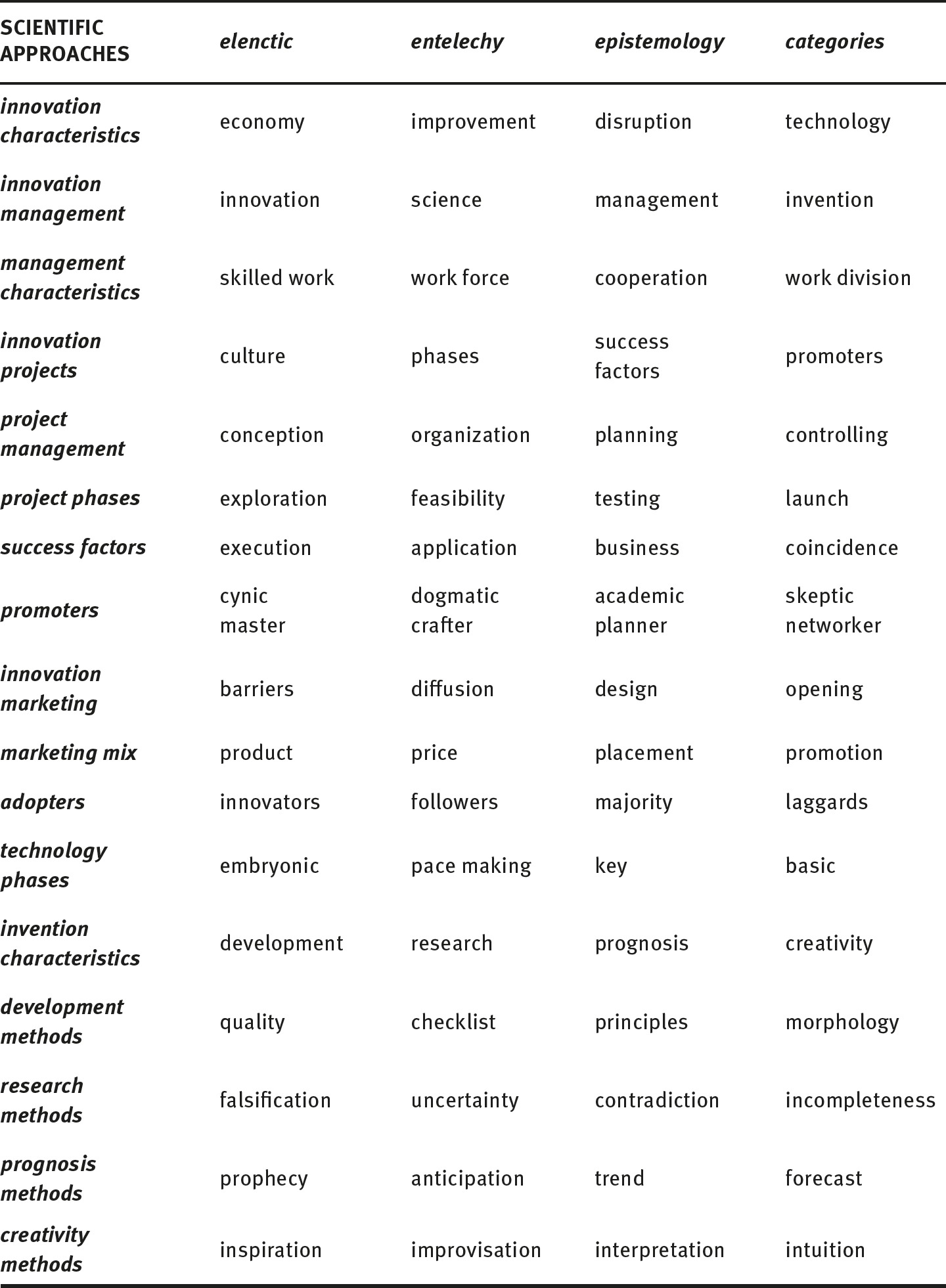System
The totality is not, as it were, a mere heap;
but the whole is something beyond the parts.
from: Metaphysics, Book VIII, Part 1 by Aristotle around 350 BC
A community is a system of common people, a society is a system of socializing individuals, an economy is a system of balanced values and business is a system of busy activities. Obviously, there is a need to distinguish between the single abilities and the abilities of a system, literally meaning a compilation, an assortment or an assembly.
Accordingly, science is a system of knowledge and this book describes the system of knowledge for the management of innovations.32 The intended surplus is a compilation, an assortment or an assembly of different approaches, aspects and methods to a whole, which exceeds the mere heap of its constituting parts.
The classical instruments of science are employed as some sort of shaft, discerned as elenctic conviction, the process of entelechy, the epistemological targets and a categorical setup. These instruments are subsequently applied to innovation projects and marketing as well as to the purpose of invention by development, research, prognosis and creativity. Each aspect contains all the four parts, respectively, with an intended reference to the related scientific instruments. The advantage of such a pattern should be a facilitated comprehensiveness, like a general blueprint, which has just to be transferred to other applications.
For instance, the initial challenge for innovation management is always some sort of conviction, be it the culture of innovation projects, the barriers to surmount in their marketing, quality problems in development or a research for falsification, a promising prophecy or a spontaneous inspiration. Apparently, the whole book could be rewritten in just another structure, yet arriving at the same systematic survey at the end.
Subsequently, all innovations need a method to proceed. The entelechy in science can be taken as phases for innovation projects and as their diffusion by marketing. Correspondingly, inventive procedures can be rolled out by a checklist for development, a systematic research for uncertainty, anticipation with roadmaps or an improvisation technique for creativity. All these proceedings should flank the striving for an improvement and for a disruption of the existing economy.
In succession, all innovations require a set of epistemological criteria for the assumed target. Projects are guided by smart success factors and their marketing is oriented by design functions; development follows inventive principles and research-related contradictions, prognosis is due to trends and creativity is enhanced by an abstract interpretation. Sure enough, there will always be single-minded managers, who just strive for success and perhaps succeed once or twice without caring about convictions or procedures. But the systematic approach furnishes also helpful options, when detrimental eventualities occur.
For, at the end, all progress is open for an arbitrary set of categories, be it the individual characters of promoters for projects or the liberality of an opening in marketing, the countless morphological combinations for development, the irremediable incompleteness of research, the conical opening in the forecasting of a scenario or the infinite possibilities of intuition by meditation.
The complexity of a scientific understanding becomes obvious, when this system is transferred to the structure in general and in detail. Innovation management starts with an elenctic approach about innovations in general, followed by a scientific entelechy in general, subsequently followed by a managerial epistemology—in general again—and leading to manifold inventive categories, in general.
In more detail, innovations can be approached by the elenctic conviction about economy, the entelechy of improvements and the epistemology of disruptions, finishing with technological categories. And in even more detail, this approach can always be applied in a self-similar way even on particular structures, for example, the project approach by conception, by organization, by planning and by controlling.
This is the original meaning of the term “metaphysics” in science, that is, an invisible substructure, which concerns every notion without being physically determined. Thereby the literal meaning of complexity as an entanglement and an enmeshment becomes apprehensible.
For instance, the organization of projects can further be substructured by convincing lines, proceeding sequences, a determining matrix and a complex learning system. And on a next level that organizational learning can again be substructured by personal masteries, mental models, shared visions and systems thinking. Each part of the structure can again be described by some constituting parts in a selfsimilar way. And any part of the structure can be considered as the start of an entire system, which may even comprise its originating structure as another part. In that way, anything becomes connected to anything else.
In consequence, the metaphysical task to manage an innovation is captured by a closely meshed network of scientific approaches in order to grasp the nonfactual notions in a somehow reliable way. Although the universe has no boundaries, it has just a limited extension in regard to its scientific understanding.
And this holds true for the universe of matter as well as for the universe of innovative ideas.
Chart 1: The systematic structure for the science of innovation.

